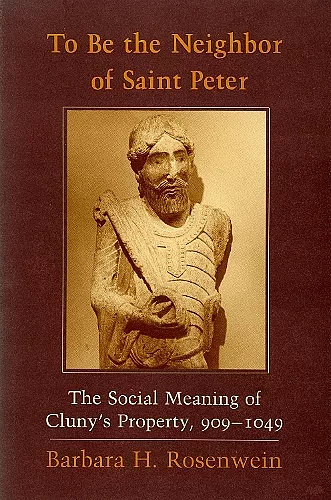To Be the Neighbor of Saint Peter
The Social Meaning of Cluny's Property, 909–1049
Format:Paperback
Publisher:Cornell University Press
Published:12th Oct '06
Currently unavailable, and unfortunately no date known when it will be back

Barbara H. Rosenwein here reassesses the significance of property in the tenth and eleventh centuries, a period of transition from the Carolingian empire to the regional monarchies of the High Middle Ages. In To Be the Neighbor of Saint Peter she explores in rich detail the question of monastic donations, illuminating the human motives, needs, and practices behind gifts of land and churches to the French monastery of Cluny during the 140 years that followed its founding. Donations, Rosenwein shows, were largely the work of neighbors, and they set up and affirmed relationships with Saint Peter, to whom Cluny was dedicated.Cluny was an eminent religious institution and served as a model for other monasteries. It attracted numerous donations and was party to many land transactions. Its charters and cartularies constitute perhaps the single richest collection of information on property for the period 909–1049. Analyzing the evidence found in these records, Rosenwein considers the precise nature of Cluny's ownership of land, the character of its claims to property, and its tutelage over the land of some of the monasteries in its ecclesia.
"The import of the title is that Cluny's property lay in a neighborhood, that is, an area with little, if any, central authority. The charters appear at first sight to be simply records of property transactions, but they are not: Rosenwein has shown they are alliances in the making, feuds being ended, and they reveal a vast network of patronage. . . . This is an important and trailblazing book well worth the effort that has gone into it."—Eric John, Catholic Historical Review
"Although Rosenwein relies heavily on quantitative evidence, her clear and often polished prose style enlivens her information considerably. Her command of the scholarly literature is likewise very impressive. The author not only gives a definitive answer to some questions regarding Cluny's property but also stimulates the posing of new questions. This book shows how quantitative social history should be done."—Robert C. Figuerira, Speculum
"To Be the Neighbor of Saint Peter is an important addition to the knowledge of an exemplary monastery. Rosenwein has developed new techniques for studying monastic property holdings and given a new insight into early medieval society."—John B. Freed, The Historian
"Rosenwein has studied the nature of Cluny's ownership of land, the character of its claims to its property, and its tutelage of the lands of the subject houses, with the benefit of direct access to and familiarity with the resources in Dijon and Münster. She also seeks to bring to bear the methods and findings of social history and anthropology. Her book thus offers a fascinating and inviting apercu of what modern methods and resources may make possible when applied to large bodies of charter material in general and especially to the charters of Cluny."—H. E. J. Cowdrey, American Historical Review
"Rosenwein . . . probes the charters and cartularies of Cluny. The results provide marvelous insights into the ways in which medieval property was conceived. . . . Rosenwein's conclusions about the social and symbolic meaning of medieval property are a healthy corrective to the anachronism that property has always been judged in narrowly economic terms."—Albert J. Schmidt, Continuity and Change
"Barbara H. Rosenwein has combined research on monastic property records with new insights into the nature of medieval property and social relations. She gracefully integrates textual analysis, prosopography, and new computer techniques."—Constance B. Bouchard, University of Akron
"For over a generation, the analytical techniques developed by Charles-Edmond Perrin and Georges Duby have enriched medieval social history. In To Be the Neighbor of Saint Peter, Barbara H. Rosenwein goes beyond them and shows that by asking the right questions one can know more than the institutional networks of individual lives."—Fredric L. Cheyette, Amherst College
ISBN: 9780801473456
Dimensions: 229mm x 152mm x 19mm
Weight: 454g
280 pages